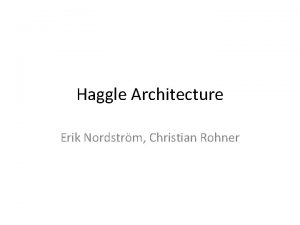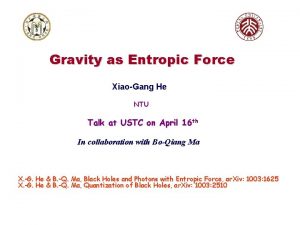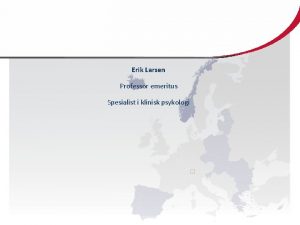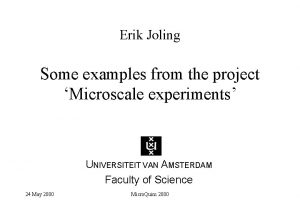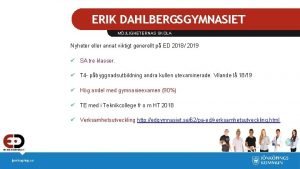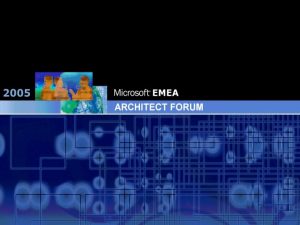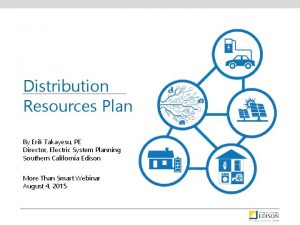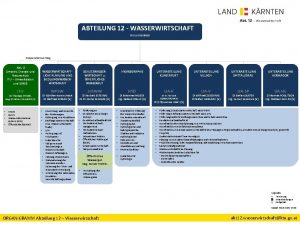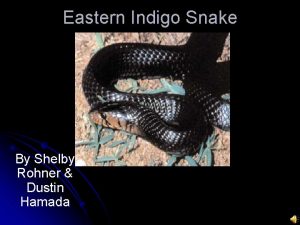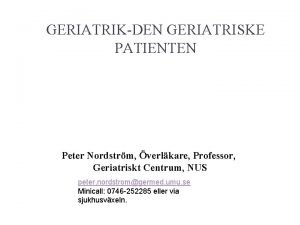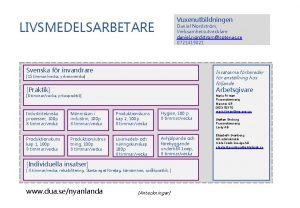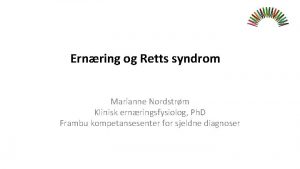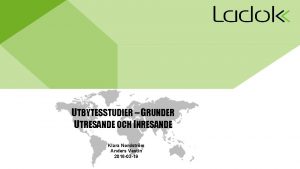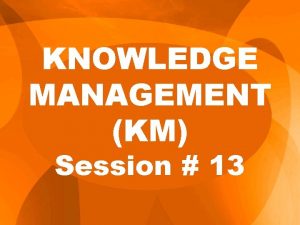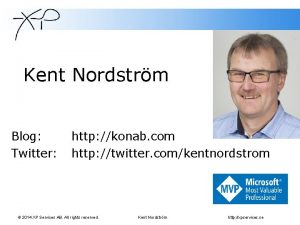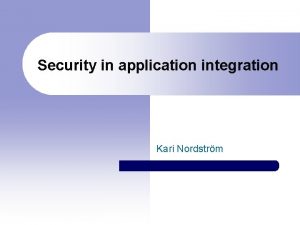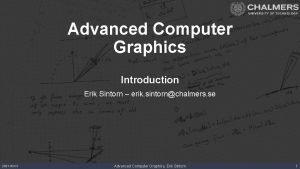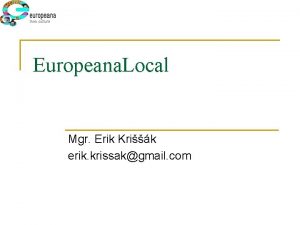Haggle Architecture Erik Nordstrm Christian Rohner Haggle Project




























- Slides: 28

Haggle Architecture Erik Nordström, Christian Rohner

Haggle Project • 4 Year EU project • 8 partners: Uppsala, Cambridge, Thomson, CNR, Eurecom, SUPSI, EPFL, LG (former Intel) • Uppsala: – Testbed (Virtual-APE) – Architecture design and implementation • People – Erik, Christian, Daniel, Fredrik

Haggle – “Ad hoc Google” Community “Search the neighborhood” Opportunistic Pocket-switched

Searching and Forwarding Search for matching content 2 Interests 3 4 1 4 Interests 3 1 2

Haggle Architecture Invariants • • • Data-centric Application-layer framing (“data objects”) Dissemination instead of conversation Late binding Asynchronous

Architecture Issues • Resolving “destinations” – Who and what is out there? • Interfacing – Physical – Language / Protocol • Content and priority • Forwarding ?

Host-centric vs. Data-centric news. bbc. co. uk www. cnn. com www. foxnews. com news. google. com

A Search-based Network Architecture • Make searching a first class networking primitive • What does searching imply? – Unstructured (meta)data – Query - Keywords/interests – Ranked results • How can searching help us in a Haggle-style networking context?

“Searching” in Early Haggle • INS-inspired namespace – Structured metadata – Hierarchical (name graph/tree) Root • Used to map from higher level name to lower level protocol/interface – Static, and pre-defined mappings • No searching – just lookup / tree traversal • How map data to user? – Implies destination oriented communication INS Service Accessibility Camera Public Washington Resolution Data-type Building 640 x 480 Picture White house

Searching on the Desktop and the Web • Consistent namespaces – Semantic filesystem (Gifford et al. 1991) • File attributes along file names • User explicitly adds metadata – Metadata extraction and indexing • Content-based search – Probabilistic models map metadata (term freq. , language models) to search terms • Context enhanced search using graph models – Google’s Page. Rank – Connections (Soule et al. 2005)

Relation Graph

Haggle Relation Graph • Each Haggle node maintains a relation graph • Vertices are data objects • Edges are relations = two data objects share an attribute • Primitives on the relation graph = network operations • Shares similarities with (local) search – E. g. , Connections [Soules et. al 2006], Apple Spotlight, Google Desktop

Relation Graph • Computer • Beer • Film • Food • Haggle • Music • Co. Re • Film • Beer • Computer 3 1 • Beer • Music • Co. Re 1 • Music • Haggle 2 1 2 • Uppsala • Cambridge • Haggle 1 2 1 1 • Food • Stockholm • Haggle • Cambridge • Haggle




Benefits of a Search Approach • Flexible “naming and addressing” – No e 2 e end-point identifiers • Late binding resolutions • Late binding demultiplexing • Content dissemination and forwarding – Ordered forwarding – Delegate forwarding and interest-based forwarding • Resource and congestion control – Limit queries – only get best matching content

Demo

Filter – Local Demultiplex Data object Induced subgraph Attribute Demux = filtering associated with an actor

Query – Weighting the graph There may be many ways to do the weighting!

Cut in Relation Graph Ranked result = {v 1, v 2} || {v 2, v 1}

Exchanging Data Objects Resolve data/content Resolve node • Since content and nodes are both data objects, these two operations are (more less) the same

Data Object Format

Searching in Haggle • Use searching to resolve mappings between data and receivers – Analogy: Top 5 hits on Google • Content ranked (priority) • Results change with the content carried

Conclusions • Search primitives are useful abstractions for DTN-style networking • Novel naming and addressing • Ranking useful for dissemination – Resource/congestion control – Ordered forwarding (priorities) • Better understanding of scaling needed – Query time – Effect on battery life?


Weighting

Query Time
 Nordstrm
Nordstrm Explain architecture business cycle
Explain architecture business cycle Data centered architecture
Data centered architecture Examples of integral product architecture
Examples of integral product architecture Modular architecture vs integrated architecture
Modular architecture vs integrated architecture Bus design in computer architecture
Bus design in computer architecture Microsoft project server demo
Microsoft project server demo Architecture project planning
Architecture project planning Sven erik gisvold
Sven erik gisvold Maslow's hierarchy of needs vs erikson's stages
Maslow's hierarchy of needs vs erikson's stages Bsimm
Bsimm Erik olin wright sınıf kuramı
Erik olin wright sınıf kuramı Erik martijnse
Erik martijnse Erikson stufenmodell der psychosozialen entwicklung tabelle
Erikson stufenmodell der psychosozialen entwicklung tabelle Kyssande vind analys
Kyssande vind analys Erik van der hoek
Erik van der hoek Lars erik smevold
Lars erik smevold Lars erik smevold
Lars erik smevold Bank robbery java code
Bank robbery java code John erik nygaard
John erik nygaard Erik peter verlinde
Erik peter verlinde Motto erik of het klein insectenboek
Motto erik of het klein insectenboek Erik larsen miljøterapi
Erik larsen miljøterapi Erik joling
Erik joling Erik homburger erikson
Erik homburger erikson Rektor erik dahlbergsgymnasiet
Rektor erik dahlbergsgymnasiet Erik gottschalk
Erik gottschalk Erik doernenburg
Erik doernenburg Erik takayesu
Erik takayesu
